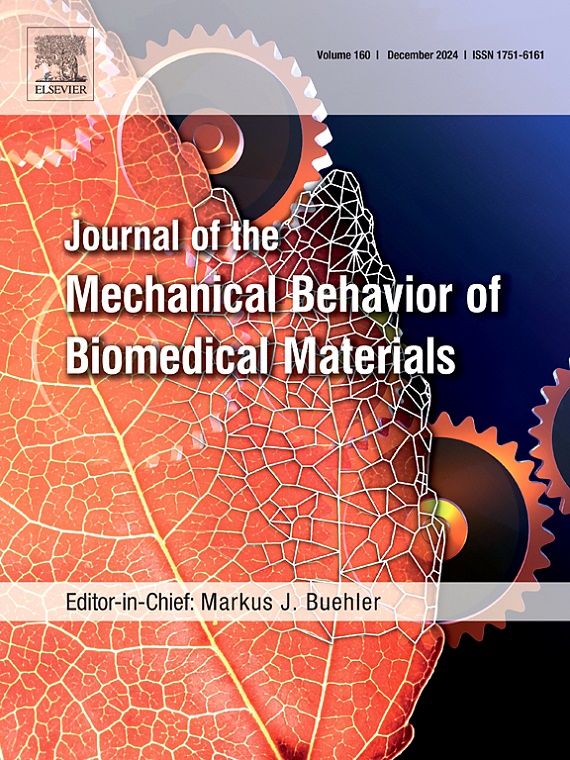与小鼠动脉瘤进展相比,不同的生理生物力学指标与正常成熟的主动脉直径增加有关
IF 3.5
2区 医学
Q2 ENGINEERING, BIOMEDICAL
Journal of the Mechanical Behavior of Biomedical Materials
Pub Date : 2025-06-20
DOI:10.1016/j.jmbbm.2025.107105
引用次数: 0
摘要
胸主动脉瘤(TAA)是马凡氏综合征(MFS)的主要心血管表现,马凡氏综合征是一种由纤维蛋白1突变引起的结缔组织疾病。动脉瘤扩张通常发生在MFS的升主动脉(ASC),但在整个动脉树中可以检测到结构和力学变化,可能导致剥离和破裂。临床处理包括测量ASC直径和/或生长速度,但通常不包括胸主动脉的其他区域,在ASC手术置换后可能发生降主动脉夹层(DSC)。在严重的MFS中,扩张伴随着主动脉成熟,因此很难区分正常和病理性的直径变化。我们使用Fbn1mgR/mgR (MU)(严重MFS模型)和野生型(WT)小鼠,并量化了1,2,3和4个月大时ASC和DSC的双轴生理生物力学指标,其中包括WT小鼠的正常生长和主动脉成熟时期以及MU小鼠的动脉瘤形成时期。结果显示年龄和位置特异性扩张和生物力学指标的改变在WT和MU主动脉中具有不同的模式。多变量混合模型显示,存储应变能和周向应力是WT ASC和DSC预测主动脉直径的主要因素,而周向和轴向增量模量(即材料刚度)是MU ASC和DSC预测主动脉直径的主要因素。结果强调了与小鼠TAA进展相比,正常成熟中与主动脉直径增加相关的不同生物力学指标。本文章由计算机程序翻译,如有差异,请以英文原文为准。
Different physiologic biomechanical metrics correlate with aortic diameter increases in normal maturation compared to aneurysm progression in mice
Thoracic aortic aneurysm (TAA) is the major cardiovascular manifestation of Marfan Syndrome (MFS), a connective tissue disorder caused by mutations in fibrillin-1. Aneurysmal dilation usually occurs in the ascending aorta (ASC) in MFS, but structural and mechanical changes are detectable throughout the arterial tree that may lead to dissection and rupture. Clinical management includes measuring ASC diameter and/or growth rate but does not typically include other regions of the thoracic aorta and dissection in the descending aorta (DSC) can occur after surgical replacement of the ASC. In severe forms of MFS, dilation forms concomitantly with aortic maturation, so it can be difficult to separate normal and pathologic changes in diameter. We used Fbn1mgR/mgR (MU) (a model of severe MFS) and wildtype (WT) mice and quantified biaxial physiologic biomechanical metrics of ASC and DSC at 1, 2, 3, and 4 months of age, which includes a period of normal growth and aortic maturation in WT mice and aneurysm formation in MU mice. The results showed age- and location-specific dilation and alterations in biomechanical metrics with different patterns in WT and MU aorta. A multivariable mixed model showed that stored strain energy and circumferential stress were the primary contributors to aortic diameter predictions in WT ASC and DSC, while circumferential and axial incremental moduli (i.e. material stiffness) were the primary contributors to aortic diameter predictions in MU ASC and DSC. The results highlight different biomechanical metrics associated with aortic diameter increases in normal maturation compared to TAA progression in mice.
求助全文
通过发布文献求助,成功后即可免费获取论文全文。
去求助
来源期刊

Journal of the Mechanical Behavior of Biomedical Materials
工程技术-材料科学:生物材料
CiteScore
7.20
自引率
7.70%
发文量
505
审稿时长
46 days
期刊介绍:
The Journal of the Mechanical Behavior of Biomedical Materials is concerned with the mechanical deformation, damage and failure under applied forces, of biological material (at the tissue, cellular and molecular levels) and of biomaterials, i.e. those materials which are designed to mimic or replace biological materials.
The primary focus of the journal is the synthesis of materials science, biology, and medical and dental science. Reports of fundamental scientific investigations are welcome, as are articles concerned with the practical application of materials in medical devices. Both experimental and theoretical work is of interest; theoretical papers will normally include comparison of predictions with experimental data, though we recognize that this may not always be appropriate. The journal also publishes technical notes concerned with emerging experimental or theoretical techniques, letters to the editor and, by invitation, review articles and papers describing existing techniques for the benefit of an interdisciplinary readership.
 求助内容:
求助内容: 应助结果提醒方式:
应助结果提醒方式:


